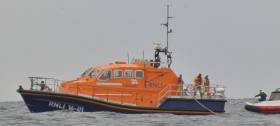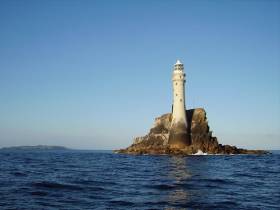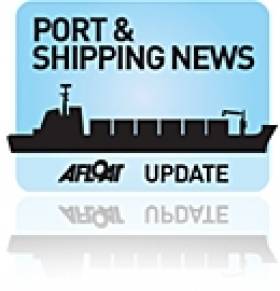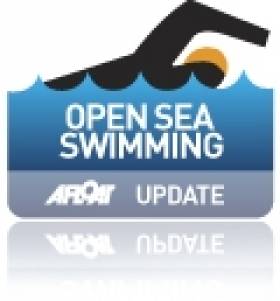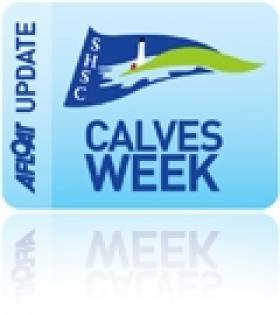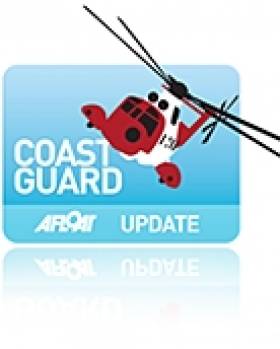Displaying items by tag: Fastnet Rock
Fastnet Callout Sees Baltimore Lifeboat Bring Two To Safety
#RNLI - Two people watching the Fastnet Race fleet round the famous rock from a RIB yesterday (Tuesday 8 August) were rescued by Baltimore RNLI when their boat lost power.
The volunteer lifeboat crew, who were already on exercise in the area of Fastnet Rock, were alerted by a call from a nearby vessel at 3.15pm that another boat with two people onboard had lost the use of their engine.
The all-lifeboat was only two miles from the casualty vessel, a 7.5m RIB. Conditions at the time were good with a north-westerly Force 2-3 wind and a one-metre sea swell.
Once on scene, the lifeboat crew established a tow and brought the vessel back to Baltimore Harbour in West Cork, securing her to the pontoon before returning to the lifeboat station at 4.20pm.
Kate Callanan, Baltimore RNLI volunteer lifeboat press officer, commented: “Thankfully the lifeboat crew were on scene very quickly after the call was raised.
“Baltimore RNLI has a strong connection to the Fastnet Race having been involved in a number of dramatic rescues over the years. The lifeboat crew regularly exercise during the famous race to be nearby in case they receive a call for help.”
Elsewhere, Wicklow’s all-weather lifeboat launched at on Monday night (7 August) to assist two sailors on a yacht in difficulties about two miles north-east of Wicklow Harbour.
The eight-metre yacht was on passage south when it developed engine problems. The skipper contacted the Irish Coast Guard for assistance as they were unable to make any progress due to the lack of wind.
Under the command of second coxswain Ciaran Doyle, the lifeboat was alongside the casualty six minutes after launching. Conditions in the area had a calm sea state with light airs and good visibility.
A towline was quickly established and the yacht was brought back to Wicklow Harbour, where it was safely secured alongside the East Pier before midnight.
Fastnet Lighthouse Part Of New Wave Action Study
#Lighthouses - Fastnet Rock is part of a new €1.3 million, three-year project studying the effects of wave action on offshore lighthouses around the UK and Ireland.
As Phys.org reports, the STORMLAMP project – or STructural behaviour Of Rock Mounted Lighthouses At the Mercy of imPulsive waves – comprises marine science researchers from University College London and the Universities of Plymouth and Exeter, some of whom have already conducted a trail at Plymouth's Eddystone Lighthouse.
The team will use specialised equipment to measure the vibrations endured by lights found in some of the roughest seas around these islands.
The recorded data will then feed into sophisticated computer models that will predict the longevity of rock-based lighthouses in Cornwall, the Channel Islands and the west coast of Scotland, besides Fastnet off West Cork, and identify whether any remedial works would be required.
Phys.org has much more on the story HERE.
Coastguard Choppers Fight Storm Desmond In Medevac Off Southwest Coast
#Rescue - Two Irish Coast Guard helicopters battled Storm Desmond to evacuate a crewman from a container ship off the southwest coast yesterday (Friday 4 December).
As UTV News reports, Rescue 117 from Waterford was joined by Rescue 115 from Shannon in the medevac some 160km west of Fastnet Rock at the Swedish-registered MV Atlantic Cartier, where the long-range-specialist Sikorsky S-92 helicopters faced strong gales and heavy seas.
According to TheJournal.ie, the ill crewman, who was reporting chest pains, was airlifted to Cork Airport where he was transferred to an ambulance.
It marks the latest rescue operation for the coastguard helicopter network in a busy 2015, which has seen a record year for Sligo's Rescue 118 in particular.
Fastnet Shipping Add New Wind-Farm Cat Support-Survey Vessel
#NewWindCat- Waterford based Fastnet Shipping Limited has added a new 22m windfarm and survey support catamaran to its fleet of marine plant hire, writes Jehan Ashmore.
The craft which has space to seat up to 27 personnel will be used to transferring construction and crew service teams for the offshore wind-farm /turbine transfer market.
As previously reported on Afloat.ie, the company since 2010 has entered this sector in UK waters, when they commissioned a quartet of multi-purpose high-speed craft wind-farm support vessels (WFSV) for the charter market.
The introduction of this fifth and larger WFSV will see the 24 knots maximum capable Fastnet Rock able to operate up to 200 nautical miles.
For further vessel specifications of the Panamanian flagged craft click HERE.
In addition to the wind-farm support vessels, Fastnet Shipping operate and charter out vessels involved in dredging contracts, harbour and coastal towage and provide offshore logistics support services.
Corkman Is Open Sea Swimming's Man Of The Year
#Swimming - Cork swimmer Steve Redmond has been named World Open Water Swimming's Man of the Year for 2012 for his record-breaking triumph in the Oceans7 Challenge last summer.
As the Southern Star declares: "Few individuals in the history of open water swimming have carried the heavy physical, mental, emotional and financial burdens that Stephen Redmond heaped upon his broad shoulders in 2012."
It marked the third year in a row that Redmond was nominated for the international award.
The Corkman had already conquered many of the world's toughest marathon swims - such as becoming the first person ever to swim from Baltimore to Schull around the Fastnet Rock - before setting sights on the Oceans7 Challenge, the open sea swimming equivalent of climbing the world's seven highest peaks.
As previously reported on Afloat.ie, he completed the final leg of the challenge when he crossed Japan's Tsugaru Strait in mid July, beating Australian marathon swimmer Penny Palfrey to the coveted accolade.
Major Cut-Back for Calves Week 2012
#CALVES WEEK – Calves week is to be cut down to a four day event this August in response to competitors requests for a shorter and less expensive event writes Claire Bateman. This year, as an alternative to the traditional event spanning a two week period, the Schull based sailing programme will consist of a four day Calves Week Championships, running from Tuesday 7th to Friday 10th of August, with the usual mix of courses taking in the Fastnet Rock and many of Carberys Hundred Isles, together with laid courses in Roaringwater Bay.
Daily prizegiving will take place on Main Street Schull where a nautical festival theme for the village is being organised by local businesses.
The traditional regattas on August Monday in Baltimore and the following Saturday and Sunday in Crookhaven and Schull will continue as stand alone events with their own courses and prizegivings being organised by the local sailing clubs.
The week will once again commence with the overnight Crosshaven/Schull race starting the activities on Friday August 3rd, while on Saturday morning August 4th the White Sail fleet will have an early start from Kinsale. Both of these races will form part of the new Scora Offshore Championships, together with the midweek Fastnet Race out of Schull.
Software Instrumental to Rescue of Rambler 100 Crew
Search and rescue mapping software developed in Rhode Island was "instrumental" in efforts to retrieve crewmembers from the stricken Rambler 100 off Fastnet last week.
The SARMAP software, developed by ASA (Applied Science Associates, Inc) provides rapid predictions of the movement of drifting objects and missing persons at sea.
For search and rescue units it can provide search patterns and calculate the probability of containment, probability of detection, and probability of success.
As previously reported on Afloat.ie, the Rambler 100 capsized off the Cork coast while competing in last weekend's Rolex Fastnet Race.
The Rambler 100’s personal locator beacon activated when the yacht overturned, which alerted rescuers to the location of the 16 stranded crewmembers still with the vessel, but recovering the five lost at sea required a more advanced approach.
The Irish Coast Guard used SARMAP’s sophisticated tracking capabilities to predict the movement of the drifting survivors and calculate a precise search area.
ASA president Eoin Howlett commented: “We have successfully worked with the Irish Coast Guard for many years; they are an innovative agency and have a history of implementing the latest in ocean technologies.
"We are very pleased that our software, combined with their rapid decision-making, resulted in such a positive outcome.”
Injured Fisherman Airlifted to Hospital by Shannon Coastguard
An injured man fisherman airlifted to hospital yesterday from a boat off Kerry coast, The Irish Times reports.
The Shannon-based Irish Coast Guard helicopter was dispatched to assist the crewmember on the UK-registered fishing vessel Achieve, some 110 miles southwest of the Blasket Islands.
He was airlifted to Tralee Regional Hospital, where he is being treated for serious injuries.
The incident marked the fourth time that the Shannon helicopter has been called into action this week.
This included its assistance of the crew of the yacht Rambler 100, which capsized near Fastnet Rock while competing in this year's Rolex Fastnet Race last weekend.
Rambler 100 Crew Member 'Feels Lucky to be Alive'
An Australian crewmember on the stricken Rambler 100, which capsized in high winds during yesterday's Rolex Fastnet Race, has told reported that he feels "lucky to be alive".
Mike Motti was one of five crew who were separated from the yacht when it overturned near Fastnet Rock off the Cork coast.
He and his fellow crewmembers spent two hours adrift on a liferaft before they were rescued in foggy conditions which made the search all the more difficult.
“I’m feeling lucky to be alive, happy to be here and it’s great to see the local people here to greet us,” Motti told The Irish Times.
Fellow crewman Michael van Beuren said the yacht capsized within 30 seconds when its keel fin snapped in heavy seas.
All 21 crew were rescued from the yacht last night in an operation led by the Baltimore RNLI lifeboat and the Irish Coast Guard.
Fastnet Yacht Capsizes Off Cork Coast - Latest
A US entrant in this year's Rolex Fastnet Race capsizsed near Fastnet Rock off the Cork coast earlier this evening, The Irish Times reports.
Further to our previous report, The Irish Times notes that 22 people were on board the Rambler 100, which overturned in force-five winds at around 6.30pm this evening.
The Department of Transport confirmed that all crew have been accounted for, with 16 sitting in the hull of the boat and the remainer on life rafts.

Rambler 100 rounds the Fastnet Rock. Photo: Daniel Forster/Rolex
RNLI Baltimore's lifeboat and the Irish Coast Guard are currently attending. Coastguard helicopters have also been dispatched, with naval vessel LE Clara giving assistance. The rescue effort has been hampered by misty conditions in the area this evening.

Baltimore lifeboat at the scene of the capsized Rambler 100. Photo: Carlo Borlenghi/Rolex
Rambler 100 recently set a new world record for the almost 3,000-nautical mile transatlantic crossing from Newport, Rhode Island to Lizard Point in Cornwall with a time of 6 days, 22 hours, 8 minutes and 2 seconds.
In other Fastnet action, there was disaster in IRC Z this afternoon for co-skippers Karl Kwok and Jim Swartz’s Farr 80 Beau Geste (HKG).
The yacht suffered a ‘structural problem’ while mid-away across the Celtic Sea en route to the Rock. She has since turned her bow back towards Land’s End.
Yesterday there was another high profile retirement when Johnny Vincent’s TP52 Pace (GBR) returned to her berth in the Hamble with mast problems.
In the Class 40s John Harris’ GryphonSolo2 (USA) has also pulled out, retiring to Dartmouth with sail damage.
- Fastnet
- Cork
- Rolex Fastnet Race
- Lifeboat
- Coastguard
- Irish Coast Guard
- Transatlantic
- Hamble
- Search and Rescue
- Fastnet Rock
- Department of Transport
- world record
- Helicopter
- 2011
- capsize
- TP52
- Land's End
- Rambler 100
- RNLI Baltimore
- IRC Z
- Kark Kwok
- Jim Swart
- Farr 80
- Beau Geste
- Johnny Vincent
- Pace
- John Harris
- GryphonSolo2
- Dartmouth
- Class 40



























